Comprehensive Report on Current Accounting Thought Development
VerifiedAdded on 2020/01/28
|9
|2584
|38
Report
AI Summary
This report provides a comprehensive overview of current developments in accounting thought. It begins by exploring the main purpose of general financial reporting, emphasizing its importance for investors, creditors, and lenders in making informed decisions. The report delves into the qualitative characteristics of financial information, focusing on relevance and reliability, and discusses the weaknesses of historical cost accounting, such as not considering price level changes and unrealistic fixed values. It also highlights the benefits of historical cost accounting, including improved efficiency and price fixation. Furthermore, the report examines the objectives of financial reporting, the role of the IASB, and the needs of various users, including investors, employees, lenders, and creditors. The report references key academic sources to support its analysis.
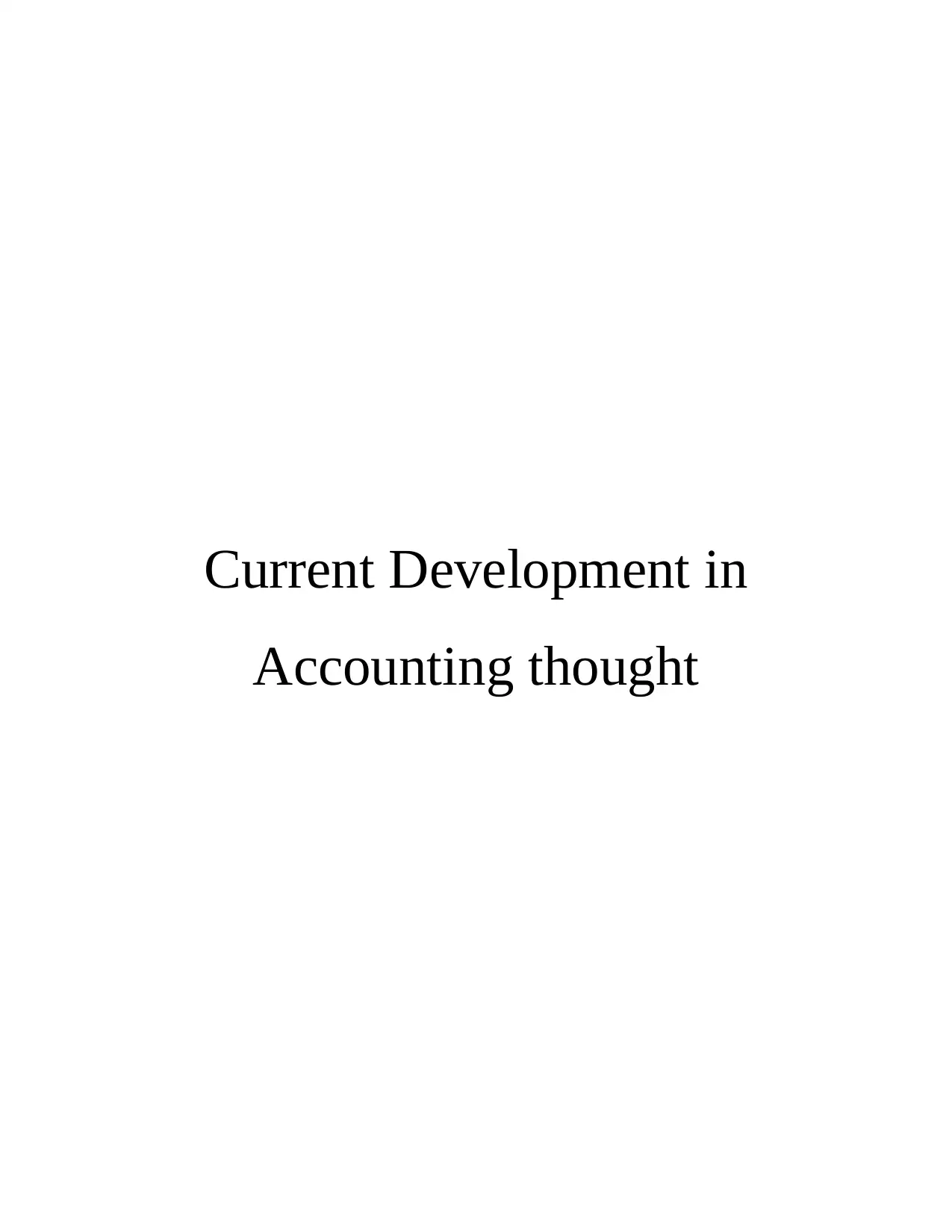
Current Development in
Accounting thought
Accounting thought
Paraphrase This Document
Need a fresh take? Get an instant paraphrase of this document with our AI Paraphraser
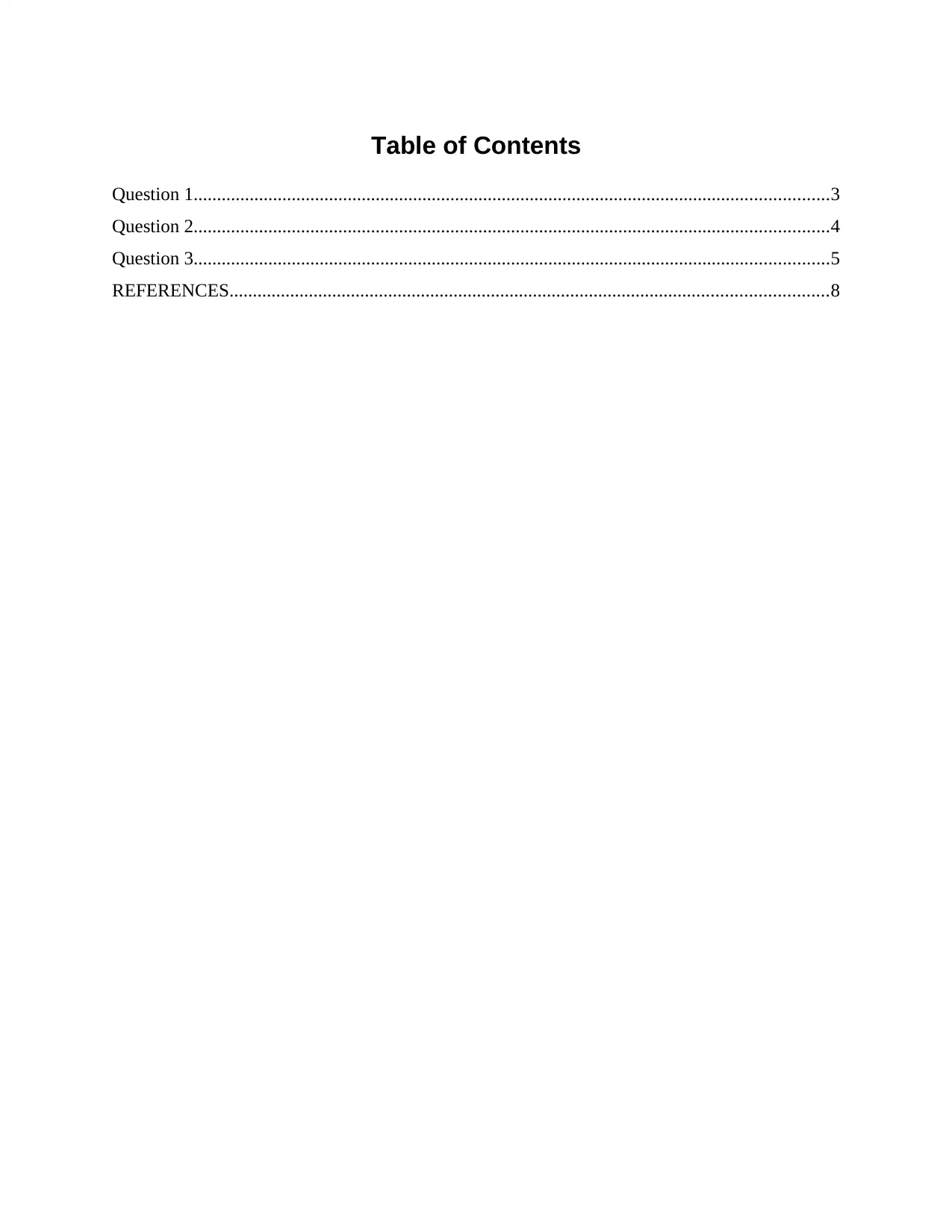
Table of Contents
Question 1........................................................................................................................................3
Question 2........................................................................................................................................4
Question 3........................................................................................................................................5
REFERENCES................................................................................................................................8
Question 1........................................................................................................................................3
Question 2........................................................................................................................................4
Question 3........................................................................................................................................5
REFERENCES................................................................................................................................8
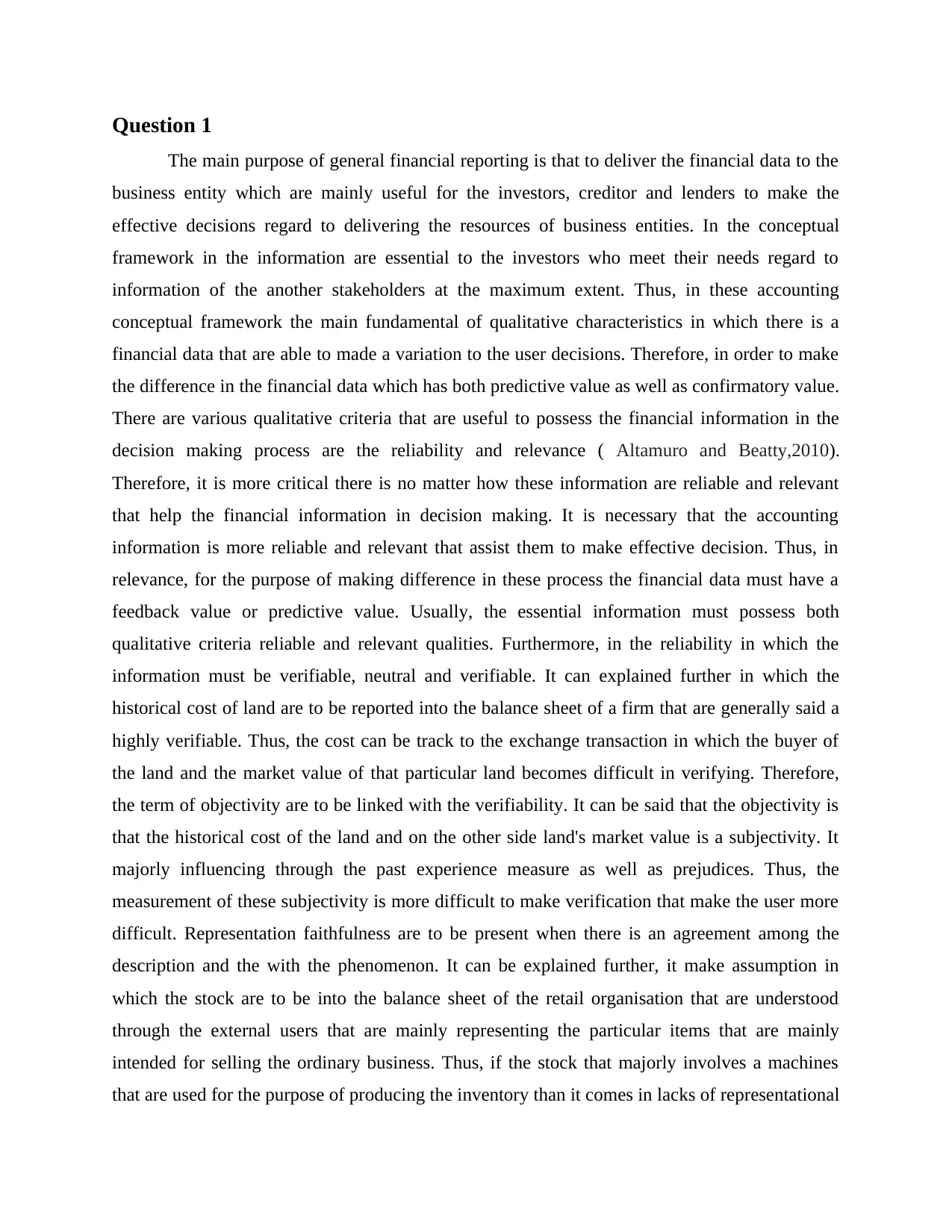
Question 1
The main purpose of general financial reporting is that to deliver the financial data to the
business entity which are mainly useful for the investors, creditor and lenders to make the
effective decisions regard to delivering the resources of business entities. In the conceptual
framework in the information are essential to the investors who meet their needs regard to
information of the another stakeholders at the maximum extent. Thus, in these accounting
conceptual framework the main fundamental of qualitative characteristics in which there is a
financial data that are able to made a variation to the user decisions. Therefore, in order to make
the difference in the financial data which has both predictive value as well as confirmatory value.
There are various qualitative criteria that are useful to possess the financial information in the
decision making process are the reliability and relevance ( Altamuro and Beatty,2010).
Therefore, it is more critical there is no matter how these information are reliable and relevant
that help the financial information in decision making. It is necessary that the accounting
information is more reliable and relevant that assist them to make effective decision. Thus, in
relevance, for the purpose of making difference in these process the financial data must have a
feedback value or predictive value. Usually, the essential information must possess both
qualitative criteria reliable and relevant qualities. Furthermore, in the reliability in which the
information must be verifiable, neutral and verifiable. It can explained further in which the
historical cost of land are to be reported into the balance sheet of a firm that are generally said a
highly verifiable. Thus, the cost can be track to the exchange transaction in which the buyer of
the land and the market value of that particular land becomes difficult in verifying. Therefore,
the term of objectivity are to be linked with the verifiability. It can be said that the objectivity is
that the historical cost of the land and on the other side land's market value is a subjectivity. It
majorly influencing through the past experience measure as well as prejudices. Thus, the
measurement of these subjectivity is more difficult to make verification that make the user more
difficult. Representation faithfulness are to be present when there is an agreement among the
description and the with the phenomenon. It can be explained further, it make assumption in
which the stock are to be into the balance sheet of the retail organisation that are understood
through the external users that are mainly representing the particular items that are mainly
intended for selling the ordinary business. Thus, if the stock that majorly involves a machines
that are used for the purpose of producing the inventory than it comes in lacks of representational
The main purpose of general financial reporting is that to deliver the financial data to the
business entity which are mainly useful for the investors, creditor and lenders to make the
effective decisions regard to delivering the resources of business entities. In the conceptual
framework in the information are essential to the investors who meet their needs regard to
information of the another stakeholders at the maximum extent. Thus, in these accounting
conceptual framework the main fundamental of qualitative characteristics in which there is a
financial data that are able to made a variation to the user decisions. Therefore, in order to make
the difference in the financial data which has both predictive value as well as confirmatory value.
There are various qualitative criteria that are useful to possess the financial information in the
decision making process are the reliability and relevance ( Altamuro and Beatty,2010).
Therefore, it is more critical there is no matter how these information are reliable and relevant
that help the financial information in decision making. It is necessary that the accounting
information is more reliable and relevant that assist them to make effective decision. Thus, in
relevance, for the purpose of making difference in these process the financial data must have a
feedback value or predictive value. Usually, the essential information must possess both
qualitative criteria reliable and relevant qualities. Furthermore, in the reliability in which the
information must be verifiable, neutral and verifiable. It can explained further in which the
historical cost of land are to be reported into the balance sheet of a firm that are generally said a
highly verifiable. Thus, the cost can be track to the exchange transaction in which the buyer of
the land and the market value of that particular land becomes difficult in verifying. Therefore,
the term of objectivity are to be linked with the verifiability. It can be said that the objectivity is
that the historical cost of the land and on the other side land's market value is a subjectivity. It
majorly influencing through the past experience measure as well as prejudices. Thus, the
measurement of these subjectivity is more difficult to make verification that make the user more
difficult. Representation faithfulness are to be present when there is an agreement among the
description and the with the phenomenon. It can be explained further, it make assumption in
which the stock are to be into the balance sheet of the retail organisation that are understood
through the external users that are mainly representing the particular items that are mainly
intended for selling the ordinary business. Thus, if the stock that majorly involves a machines
that are used for the purpose of producing the inventory than it comes in lacks of representational
⊘ This is a preview!⊘
Do you want full access?
Subscribe today to unlock all pages.

Trusted by 1+ million students worldwide
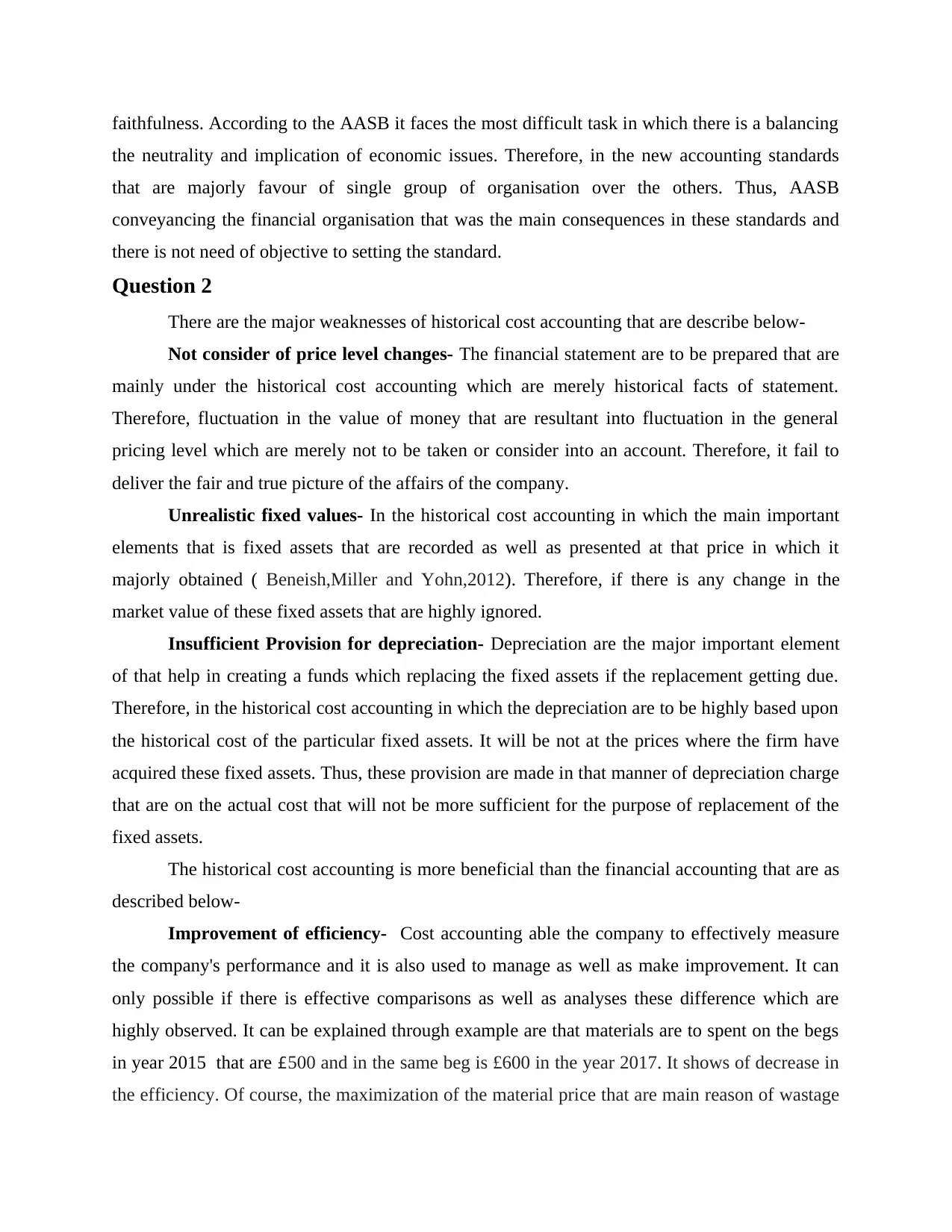
faithfulness. According to the AASB it faces the most difficult task in which there is a balancing
the neutrality and implication of economic issues. Therefore, in the new accounting standards
that are majorly favour of single group of organisation over the others. Thus, AASB
conveyancing the financial organisation that was the main consequences in these standards and
there is not need of objective to setting the standard.
Question 2
There are the major weaknesses of historical cost accounting that are describe below-
Not consider of price level changes- The financial statement are to be prepared that are
mainly under the historical cost accounting which are merely historical facts of statement.
Therefore, fluctuation in the value of money that are resultant into fluctuation in the general
pricing level which are merely not to be taken or consider into an account. Therefore, it fail to
deliver the fair and true picture of the affairs of the company.
Unrealistic fixed values- In the historical cost accounting in which the main important
elements that is fixed assets that are recorded as well as presented at that price in which it
majorly obtained ( Beneish,Miller and Yohn,2012). Therefore, if there is any change in the
market value of these fixed assets that are highly ignored.
Insufficient Provision for depreciation- Depreciation are the major important element
of that help in creating a funds which replacing the fixed assets if the replacement getting due.
Therefore, in the historical cost accounting in which the depreciation are to be highly based upon
the historical cost of the particular fixed assets. It will be not at the prices where the firm have
acquired these fixed assets. Thus, these provision are made in that manner of depreciation charge
that are on the actual cost that will not be more sufficient for the purpose of replacement of the
fixed assets.
The historical cost accounting is more beneficial than the financial accounting that are as
described below-
Improvement of efficiency- Cost accounting able the company to effectively measure
the company's performance and it is also used to manage as well as make improvement. It can
only possible if there is effective comparisons as well as analyses these difference which are
highly observed. It can be explained through example are that materials are to spent on the begs
in year 2015 that are £500 and in the same beg is £600 in the year 2017. It shows of decrease in
the efficiency. Of course, the maximization of the material price that are main reason of wastage
the neutrality and implication of economic issues. Therefore, in the new accounting standards
that are majorly favour of single group of organisation over the others. Thus, AASB
conveyancing the financial organisation that was the main consequences in these standards and
there is not need of objective to setting the standard.
Question 2
There are the major weaknesses of historical cost accounting that are describe below-
Not consider of price level changes- The financial statement are to be prepared that are
mainly under the historical cost accounting which are merely historical facts of statement.
Therefore, fluctuation in the value of money that are resultant into fluctuation in the general
pricing level which are merely not to be taken or consider into an account. Therefore, it fail to
deliver the fair and true picture of the affairs of the company.
Unrealistic fixed values- In the historical cost accounting in which the main important
elements that is fixed assets that are recorded as well as presented at that price in which it
majorly obtained ( Beneish,Miller and Yohn,2012). Therefore, if there is any change in the
market value of these fixed assets that are highly ignored.
Insufficient Provision for depreciation- Depreciation are the major important element
of that help in creating a funds which replacing the fixed assets if the replacement getting due.
Therefore, in the historical cost accounting in which the depreciation are to be highly based upon
the historical cost of the particular fixed assets. It will be not at the prices where the firm have
acquired these fixed assets. Thus, these provision are made in that manner of depreciation charge
that are on the actual cost that will not be more sufficient for the purpose of replacement of the
fixed assets.
The historical cost accounting is more beneficial than the financial accounting that are as
described below-
Improvement of efficiency- Cost accounting able the company to effectively measure
the company's performance and it is also used to manage as well as make improvement. It can
only possible if there is effective comparisons as well as analyses these difference which are
highly observed. It can be explained through example are that materials are to spent on the begs
in year 2015 that are £500 and in the same beg is £600 in the year 2017. It shows of decrease in
the efficiency. Of course, the maximization of the material price that are main reason of wastage
Paraphrase This Document
Need a fresh take? Get an instant paraphrase of this document with our AI Paraphraser
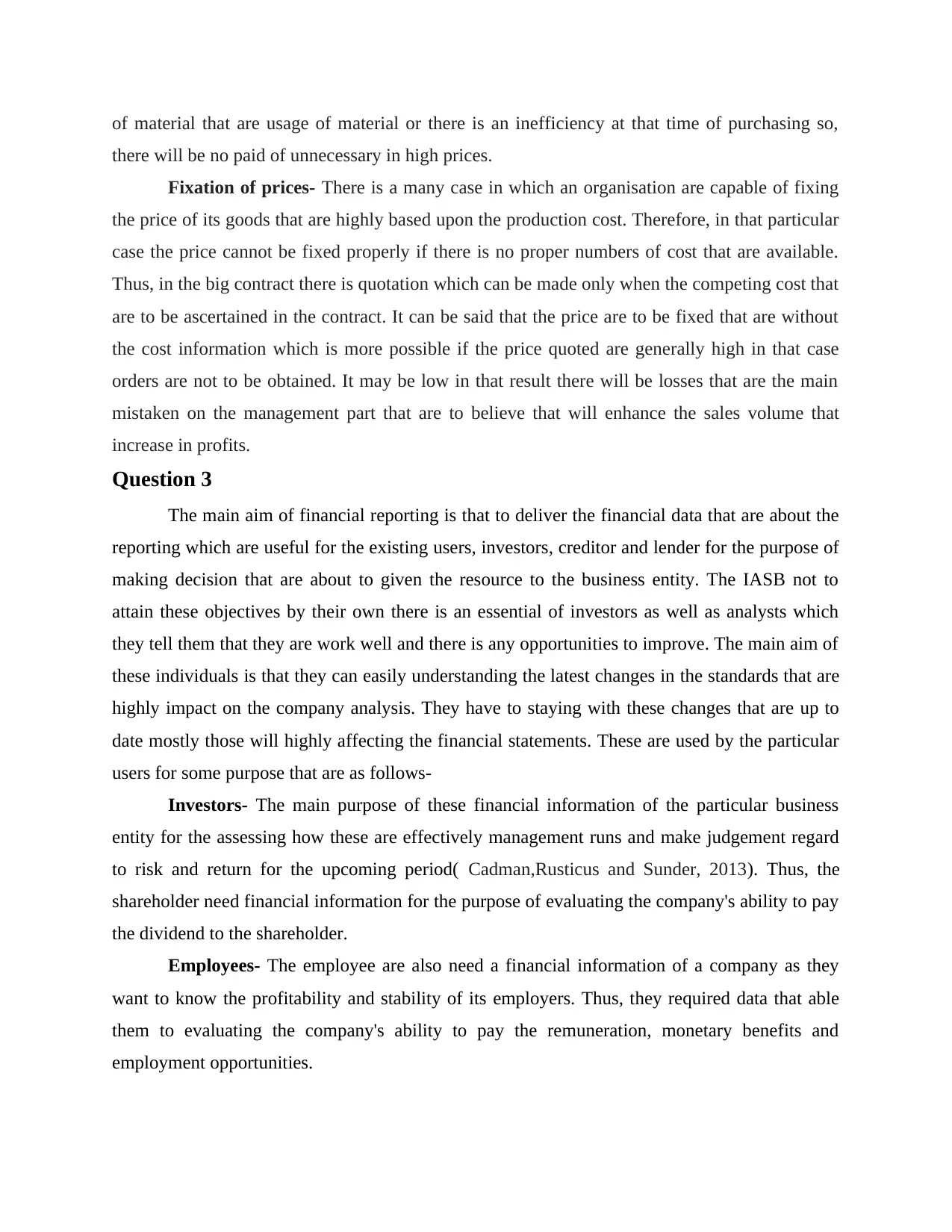
of material that are usage of material or there is an inefficiency at that time of purchasing so,
there will be no paid of unnecessary in high prices.
Fixation of prices- There is a many case in which an organisation are capable of fixing
the price of its goods that are highly based upon the production cost. Therefore, in that particular
case the price cannot be fixed properly if there is no proper numbers of cost that are available.
Thus, in the big contract there is quotation which can be made only when the competing cost that
are to be ascertained in the contract. It can be said that the price are to be fixed that are without
the cost information which is more possible if the price quoted are generally high in that case
orders are not to be obtained. It may be low in that result there will be losses that are the main
mistaken on the management part that are to believe that will enhance the sales volume that
increase in profits.
Question 3
The main aim of financial reporting is that to deliver the financial data that are about the
reporting which are useful for the existing users, investors, creditor and lender for the purpose of
making decision that are about to given the resource to the business entity. The IASB not to
attain these objectives by their own there is an essential of investors as well as analysts which
they tell them that they are work well and there is any opportunities to improve. The main aim of
these individuals is that they can easily understanding the latest changes in the standards that are
highly impact on the company analysis. They have to staying with these changes that are up to
date mostly those will highly affecting the financial statements. These are used by the particular
users for some purpose that are as follows-
Investors- The main purpose of these financial information of the particular business
entity for the assessing how these are effectively management runs and make judgement regard
to risk and return for the upcoming period( Cadman,Rusticus and Sunder, 2013). Thus, the
shareholder need financial information for the purpose of evaluating the company's ability to pay
the dividend to the shareholder.
Employees- The employee are also need a financial information of a company as they
want to know the profitability and stability of its employers. Thus, they required data that able
them to evaluating the company's ability to pay the remuneration, monetary benefits and
employment opportunities.
there will be no paid of unnecessary in high prices.
Fixation of prices- There is a many case in which an organisation are capable of fixing
the price of its goods that are highly based upon the production cost. Therefore, in that particular
case the price cannot be fixed properly if there is no proper numbers of cost that are available.
Thus, in the big contract there is quotation which can be made only when the competing cost that
are to be ascertained in the contract. It can be said that the price are to be fixed that are without
the cost information which is more possible if the price quoted are generally high in that case
orders are not to be obtained. It may be low in that result there will be losses that are the main
mistaken on the management part that are to believe that will enhance the sales volume that
increase in profits.
Question 3
The main aim of financial reporting is that to deliver the financial data that are about the
reporting which are useful for the existing users, investors, creditor and lender for the purpose of
making decision that are about to given the resource to the business entity. The IASB not to
attain these objectives by their own there is an essential of investors as well as analysts which
they tell them that they are work well and there is any opportunities to improve. The main aim of
these individuals is that they can easily understanding the latest changes in the standards that are
highly impact on the company analysis. They have to staying with these changes that are up to
date mostly those will highly affecting the financial statements. These are used by the particular
users for some purpose that are as follows-
Investors- The main purpose of these financial information of the particular business
entity for the assessing how these are effectively management runs and make judgement regard
to risk and return for the upcoming period( Cadman,Rusticus and Sunder, 2013). Thus, the
shareholder need financial information for the purpose of evaluating the company's ability to pay
the dividend to the shareholder.
Employees- The employee are also need a financial information of a company as they
want to know the profitability and stability of its employers. Thus, they required data that able
them to evaluating the company's ability to pay the remuneration, monetary benefits and
employment opportunities.
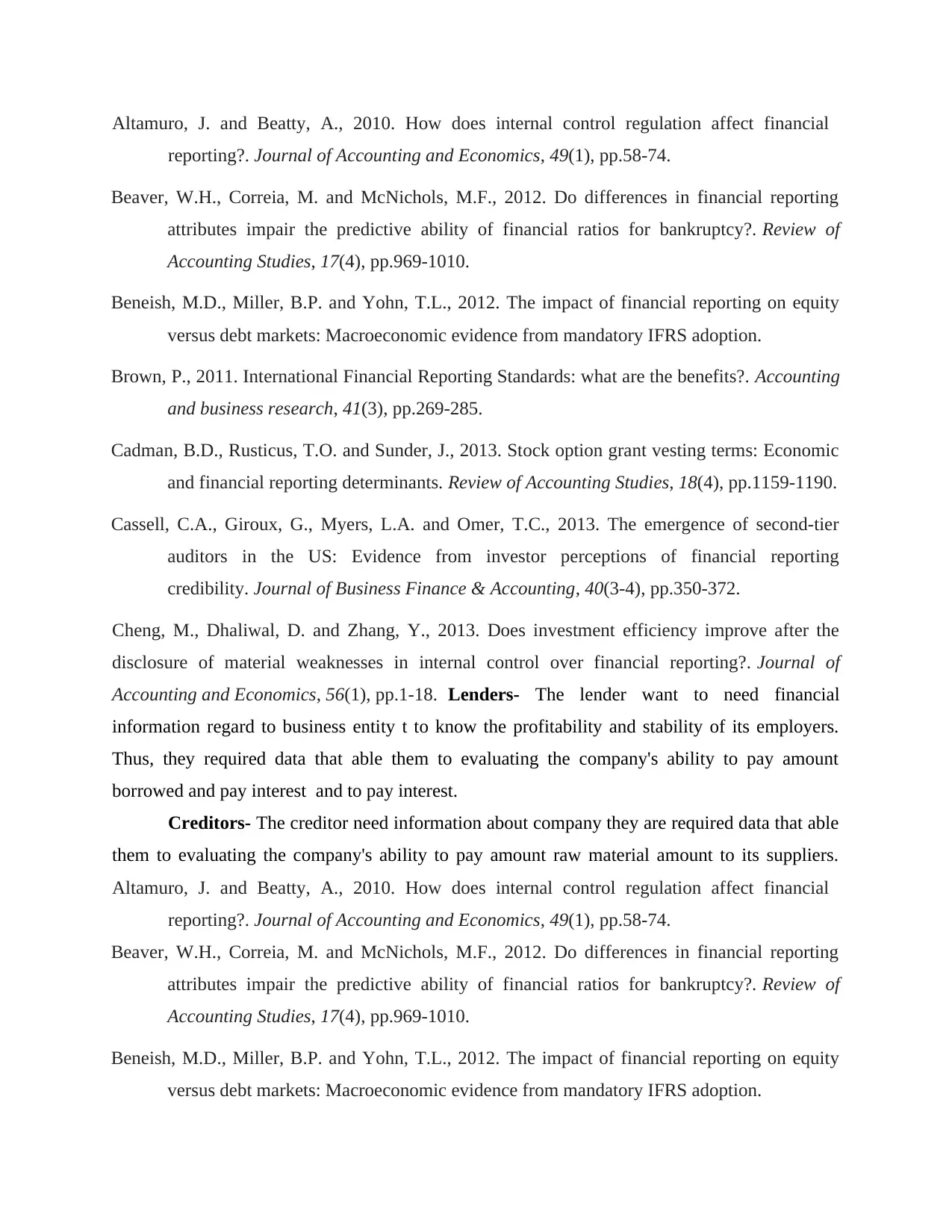
Altamuro, J. and Beatty, A., 2010. How does internal control regulation affect financial
reporting?. Journal of Accounting and Economics, 49(1), pp.58-74.
Beaver, W.H., Correia, M. and McNichols, M.F., 2012. Do differences in financial reporting
attributes impair the predictive ability of financial ratios for bankruptcy?. Review of
Accounting Studies, 17(4), pp.969-1010.
Beneish, M.D., Miller, B.P. and Yohn, T.L., 2012. The impact of financial reporting on equity
versus debt markets: Macroeconomic evidence from mandatory IFRS adoption.
Brown, P., 2011. International Financial Reporting Standards: what are the benefits?. Accounting
and business research, 41(3), pp.269-285.
Cadman, B.D., Rusticus, T.O. and Sunder, J., 2013. Stock option grant vesting terms: Economic
and financial reporting determinants. Review of Accounting Studies, 18(4), pp.1159-1190.
Cassell, C.A., Giroux, G., Myers, L.A. and Omer, T.C., 2013. The emergence of second‐tier
auditors in the US: Evidence from investor perceptions of financial reporting
credibility. Journal of Business Finance & Accounting, 40(3-4), pp.350-372.
Cheng, M., Dhaliwal, D. and Zhang, Y., 2013. Does investment efficiency improve after the
disclosure of material weaknesses in internal control over financial reporting?. Journal of
Accounting and Economics, 56(1), pp.1-18. Lenders- The lender want to need financial
information regard to business entity t to know the profitability and stability of its employers.
Thus, they required data that able them to evaluating the company's ability to pay amount
borrowed and pay interest and to pay interest.
Creditors- The creditor need information about company they are required data that able
them to evaluating the company's ability to pay amount raw material amount to its suppliers.
Altamuro, J. and Beatty, A., 2010. How does internal control regulation affect financial
reporting?. Journal of Accounting and Economics, 49(1), pp.58-74.
Beaver, W.H., Correia, M. and McNichols, M.F., 2012. Do differences in financial reporting
attributes impair the predictive ability of financial ratios for bankruptcy?. Review of
Accounting Studies, 17(4), pp.969-1010.
Beneish, M.D., Miller, B.P. and Yohn, T.L., 2012. The impact of financial reporting on equity
versus debt markets: Macroeconomic evidence from mandatory IFRS adoption.
reporting?. Journal of Accounting and Economics, 49(1), pp.58-74.
Beaver, W.H., Correia, M. and McNichols, M.F., 2012. Do differences in financial reporting
attributes impair the predictive ability of financial ratios for bankruptcy?. Review of
Accounting Studies, 17(4), pp.969-1010.
Beneish, M.D., Miller, B.P. and Yohn, T.L., 2012. The impact of financial reporting on equity
versus debt markets: Macroeconomic evidence from mandatory IFRS adoption.
Brown, P., 2011. International Financial Reporting Standards: what are the benefits?. Accounting
and business research, 41(3), pp.269-285.
Cadman, B.D., Rusticus, T.O. and Sunder, J., 2013. Stock option grant vesting terms: Economic
and financial reporting determinants. Review of Accounting Studies, 18(4), pp.1159-1190.
Cassell, C.A., Giroux, G., Myers, L.A. and Omer, T.C., 2013. The emergence of second‐tier
auditors in the US: Evidence from investor perceptions of financial reporting
credibility. Journal of Business Finance & Accounting, 40(3-4), pp.350-372.
Cheng, M., Dhaliwal, D. and Zhang, Y., 2013. Does investment efficiency improve after the
disclosure of material weaknesses in internal control over financial reporting?. Journal of
Accounting and Economics, 56(1), pp.1-18. Lenders- The lender want to need financial
information regard to business entity t to know the profitability and stability of its employers.
Thus, they required data that able them to evaluating the company's ability to pay amount
borrowed and pay interest and to pay interest.
Creditors- The creditor need information about company they are required data that able
them to evaluating the company's ability to pay amount raw material amount to its suppliers.
Altamuro, J. and Beatty, A., 2010. How does internal control regulation affect financial
reporting?. Journal of Accounting and Economics, 49(1), pp.58-74.
Beaver, W.H., Correia, M. and McNichols, M.F., 2012. Do differences in financial reporting
attributes impair the predictive ability of financial ratios for bankruptcy?. Review of
Accounting Studies, 17(4), pp.969-1010.
Beneish, M.D., Miller, B.P. and Yohn, T.L., 2012. The impact of financial reporting on equity
versus debt markets: Macroeconomic evidence from mandatory IFRS adoption.
⊘ This is a preview!⊘
Do you want full access?
Subscribe today to unlock all pages.

Trusted by 1+ million students worldwide
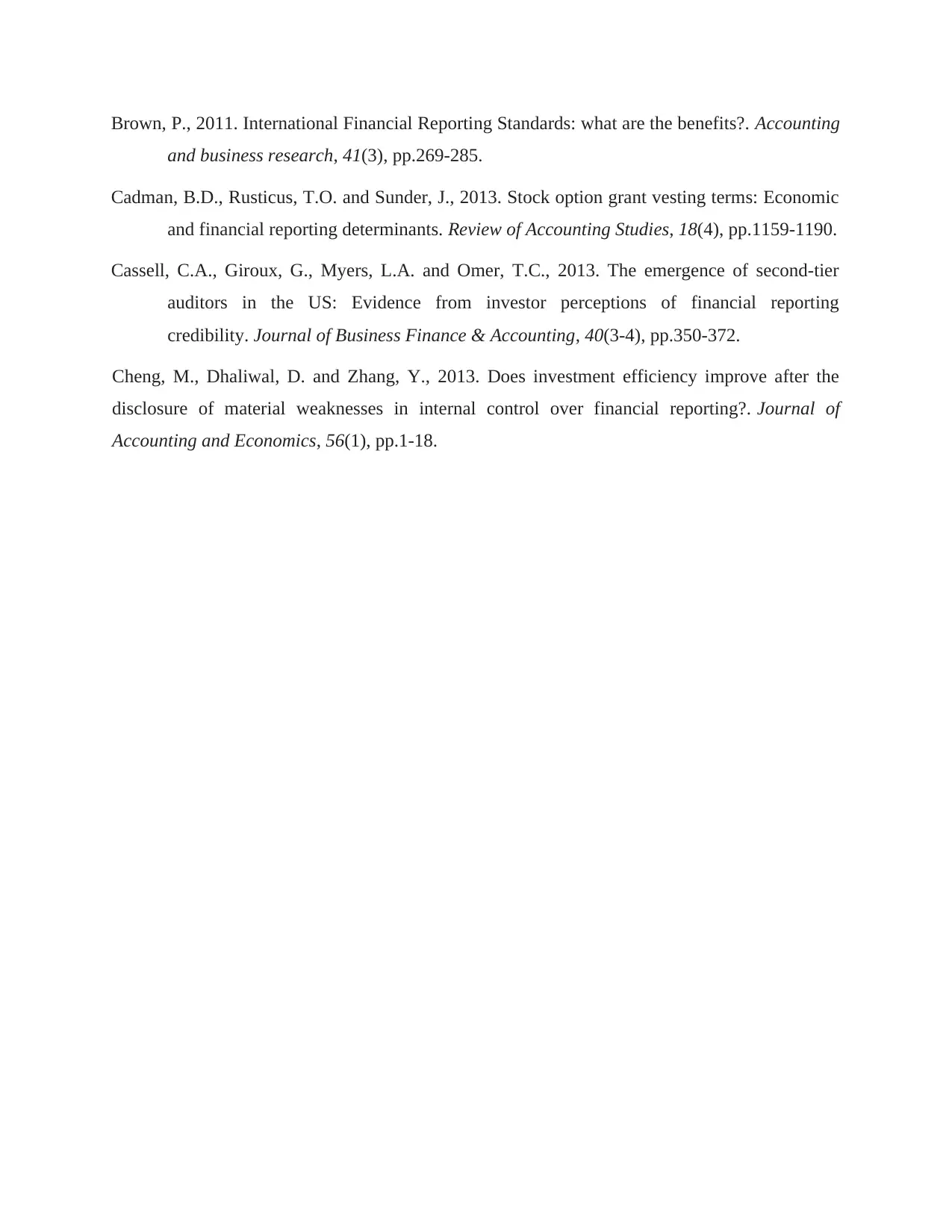
Brown, P., 2011. International Financial Reporting Standards: what are the benefits?. Accounting
and business research, 41(3), pp.269-285.
Cadman, B.D., Rusticus, T.O. and Sunder, J., 2013. Stock option grant vesting terms: Economic
and financial reporting determinants. Review of Accounting Studies, 18(4), pp.1159-1190.
Cassell, C.A., Giroux, G., Myers, L.A. and Omer, T.C., 2013. The emergence of second‐tier
auditors in the US: Evidence from investor perceptions of financial reporting
credibility. Journal of Business Finance & Accounting, 40(3-4), pp.350-372.
Cheng, M., Dhaliwal, D. and Zhang, Y., 2013. Does investment efficiency improve after the
disclosure of material weaknesses in internal control over financial reporting?. Journal of
Accounting and Economics, 56(1), pp.1-18.
and business research, 41(3), pp.269-285.
Cadman, B.D., Rusticus, T.O. and Sunder, J., 2013. Stock option grant vesting terms: Economic
and financial reporting determinants. Review of Accounting Studies, 18(4), pp.1159-1190.
Cassell, C.A., Giroux, G., Myers, L.A. and Omer, T.C., 2013. The emergence of second‐tier
auditors in the US: Evidence from investor perceptions of financial reporting
credibility. Journal of Business Finance & Accounting, 40(3-4), pp.350-372.
Cheng, M., Dhaliwal, D. and Zhang, Y., 2013. Does investment efficiency improve after the
disclosure of material weaknesses in internal control over financial reporting?. Journal of
Accounting and Economics, 56(1), pp.1-18.
Paraphrase This Document
Need a fresh take? Get an instant paraphrase of this document with our AI Paraphraser
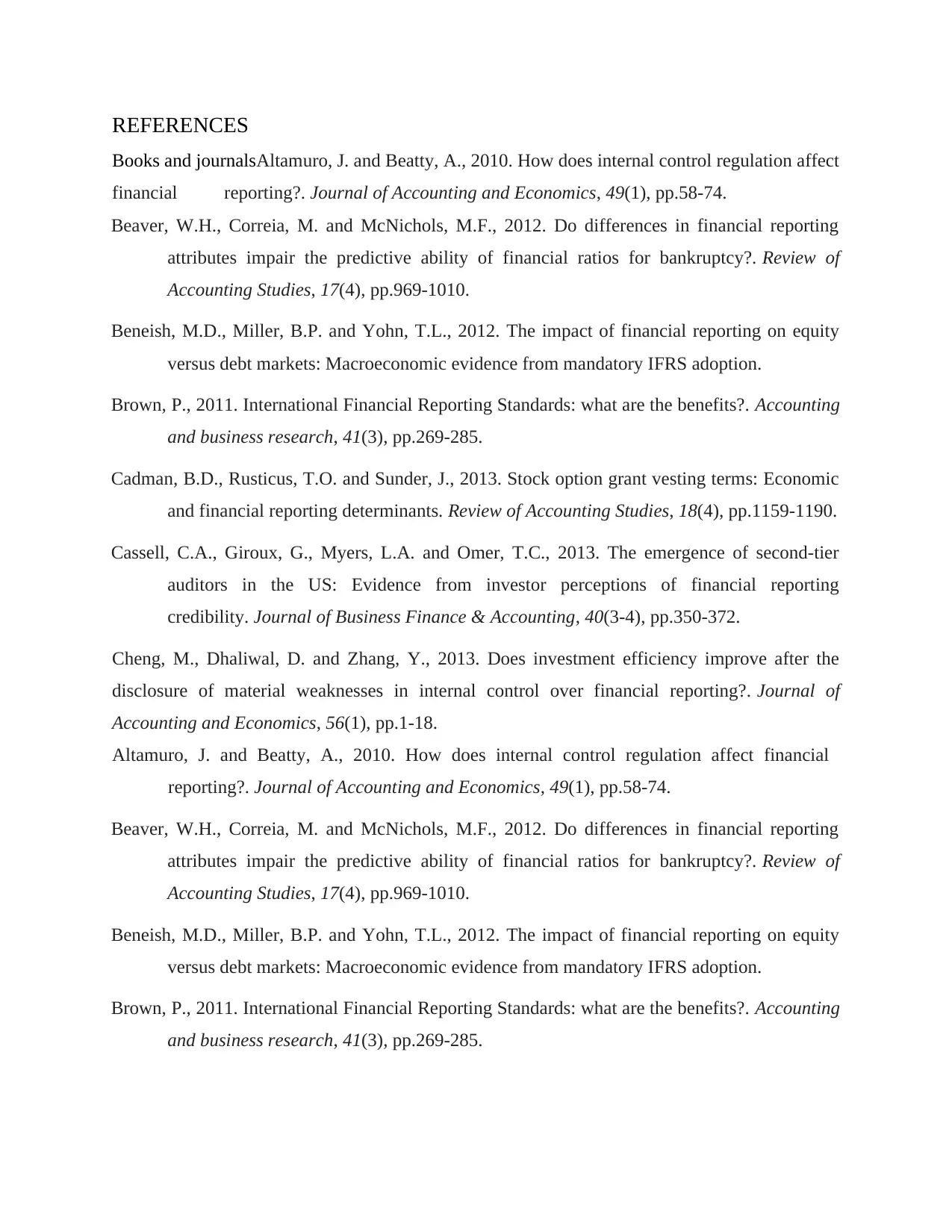
REFERENCES
Books and journalsAltamuro, J. and Beatty, A., 2010. How does internal control regulation affect
financial reporting?. Journal of Accounting and Economics, 49(1), pp.58-74.
Beaver, W.H., Correia, M. and McNichols, M.F., 2012. Do differences in financial reporting
attributes impair the predictive ability of financial ratios for bankruptcy?. Review of
Accounting Studies, 17(4), pp.969-1010.
Beneish, M.D., Miller, B.P. and Yohn, T.L., 2012. The impact of financial reporting on equity
versus debt markets: Macroeconomic evidence from mandatory IFRS adoption.
Brown, P., 2011. International Financial Reporting Standards: what are the benefits?. Accounting
and business research, 41(3), pp.269-285.
Cadman, B.D., Rusticus, T.O. and Sunder, J., 2013. Stock option grant vesting terms: Economic
and financial reporting determinants. Review of Accounting Studies, 18(4), pp.1159-1190.
Cassell, C.A., Giroux, G., Myers, L.A. and Omer, T.C., 2013. The emergence of second‐tier
auditors in the US: Evidence from investor perceptions of financial reporting
credibility. Journal of Business Finance & Accounting, 40(3-4), pp.350-372.
Cheng, M., Dhaliwal, D. and Zhang, Y., 2013. Does investment efficiency improve after the
disclosure of material weaknesses in internal control over financial reporting?. Journal of
Accounting and Economics, 56(1), pp.1-18.
Altamuro, J. and Beatty, A., 2010. How does internal control regulation affect financial
reporting?. Journal of Accounting and Economics, 49(1), pp.58-74.
Beaver, W.H., Correia, M. and McNichols, M.F., 2012. Do differences in financial reporting
attributes impair the predictive ability of financial ratios for bankruptcy?. Review of
Accounting Studies, 17(4), pp.969-1010.
Beneish, M.D., Miller, B.P. and Yohn, T.L., 2012. The impact of financial reporting on equity
versus debt markets: Macroeconomic evidence from mandatory IFRS adoption.
Brown, P., 2011. International Financial Reporting Standards: what are the benefits?. Accounting
and business research, 41(3), pp.269-285.
Books and journalsAltamuro, J. and Beatty, A., 2010. How does internal control regulation affect
financial reporting?. Journal of Accounting and Economics, 49(1), pp.58-74.
Beaver, W.H., Correia, M. and McNichols, M.F., 2012. Do differences in financial reporting
attributes impair the predictive ability of financial ratios for bankruptcy?. Review of
Accounting Studies, 17(4), pp.969-1010.
Beneish, M.D., Miller, B.P. and Yohn, T.L., 2012. The impact of financial reporting on equity
versus debt markets: Macroeconomic evidence from mandatory IFRS adoption.
Brown, P., 2011. International Financial Reporting Standards: what are the benefits?. Accounting
and business research, 41(3), pp.269-285.
Cadman, B.D., Rusticus, T.O. and Sunder, J., 2013. Stock option grant vesting terms: Economic
and financial reporting determinants. Review of Accounting Studies, 18(4), pp.1159-1190.
Cassell, C.A., Giroux, G., Myers, L.A. and Omer, T.C., 2013. The emergence of second‐tier
auditors in the US: Evidence from investor perceptions of financial reporting
credibility. Journal of Business Finance & Accounting, 40(3-4), pp.350-372.
Cheng, M., Dhaliwal, D. and Zhang, Y., 2013. Does investment efficiency improve after the
disclosure of material weaknesses in internal control over financial reporting?. Journal of
Accounting and Economics, 56(1), pp.1-18.
Altamuro, J. and Beatty, A., 2010. How does internal control regulation affect financial
reporting?. Journal of Accounting and Economics, 49(1), pp.58-74.
Beaver, W.H., Correia, M. and McNichols, M.F., 2012. Do differences in financial reporting
attributes impair the predictive ability of financial ratios for bankruptcy?. Review of
Accounting Studies, 17(4), pp.969-1010.
Beneish, M.D., Miller, B.P. and Yohn, T.L., 2012. The impact of financial reporting on equity
versus debt markets: Macroeconomic evidence from mandatory IFRS adoption.
Brown, P., 2011. International Financial Reporting Standards: what are the benefits?. Accounting
and business research, 41(3), pp.269-285.
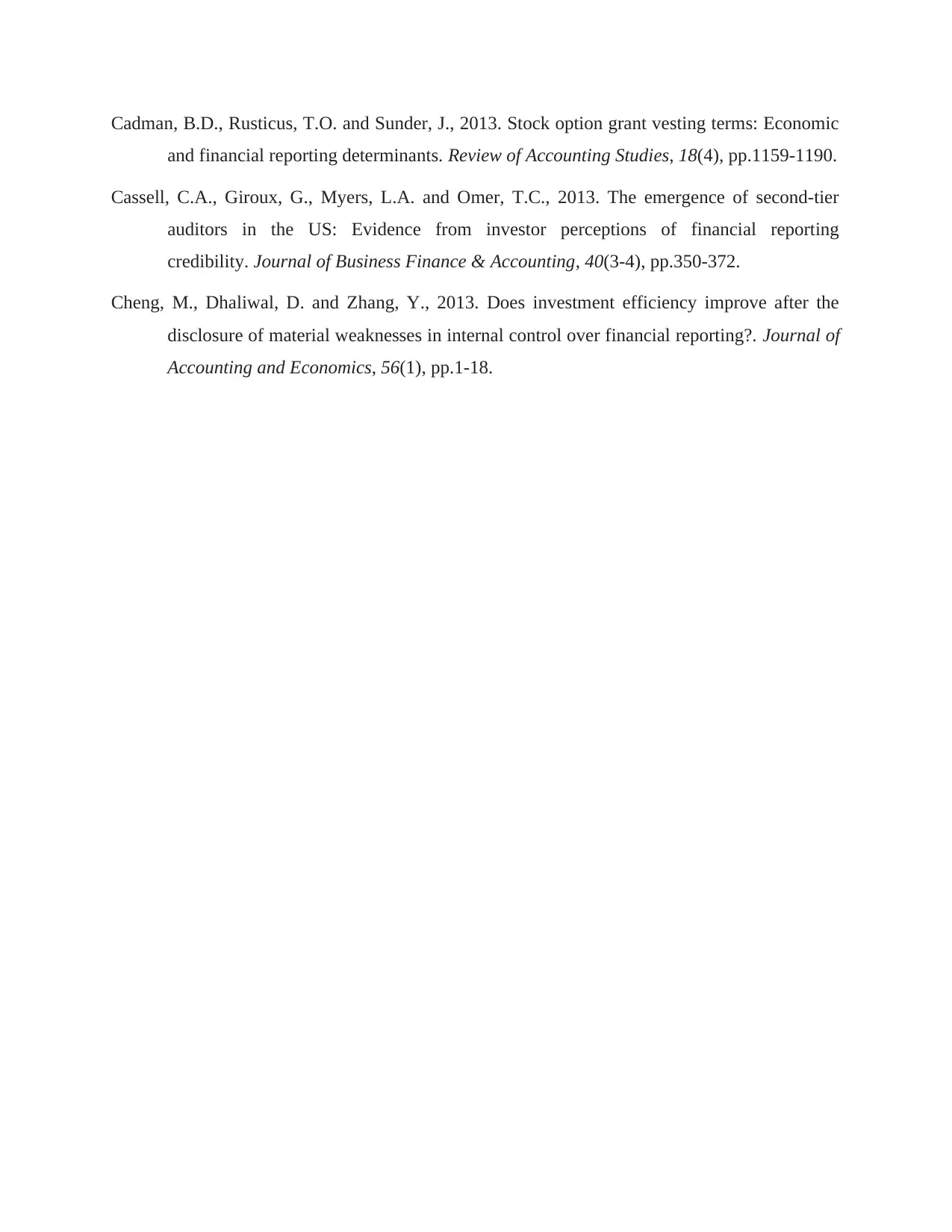
Cadman, B.D., Rusticus, T.O. and Sunder, J., 2013. Stock option grant vesting terms: Economic
and financial reporting determinants. Review of Accounting Studies, 18(4), pp.1159-1190.
Cassell, C.A., Giroux, G., Myers, L.A. and Omer, T.C., 2013. The emergence of second‐tier
auditors in the US: Evidence from investor perceptions of financial reporting
credibility. Journal of Business Finance & Accounting, 40(3-4), pp.350-372.
Cheng, M., Dhaliwal, D. and Zhang, Y., 2013. Does investment efficiency improve after the
disclosure of material weaknesses in internal control over financial reporting?. Journal of
Accounting and Economics, 56(1), pp.1-18.
and financial reporting determinants. Review of Accounting Studies, 18(4), pp.1159-1190.
Cassell, C.A., Giroux, G., Myers, L.A. and Omer, T.C., 2013. The emergence of second‐tier
auditors in the US: Evidence from investor perceptions of financial reporting
credibility. Journal of Business Finance & Accounting, 40(3-4), pp.350-372.
Cheng, M., Dhaliwal, D. and Zhang, Y., 2013. Does investment efficiency improve after the
disclosure of material weaknesses in internal control over financial reporting?. Journal of
Accounting and Economics, 56(1), pp.1-18.
⊘ This is a preview!⊘
Do you want full access?
Subscribe today to unlock all pages.

Trusted by 1+ million students worldwide
1 out of 9
Related Documents
Your All-in-One AI-Powered Toolkit for Academic Success.
+13062052269
info@desklib.com
Available 24*7 on WhatsApp / Email
![[object Object]](/_next/static/media/star-bottom.7253800d.svg)
Unlock your academic potential
Copyright © 2020–2025 A2Z Services. All Rights Reserved. Developed and managed by ZUCOL.





